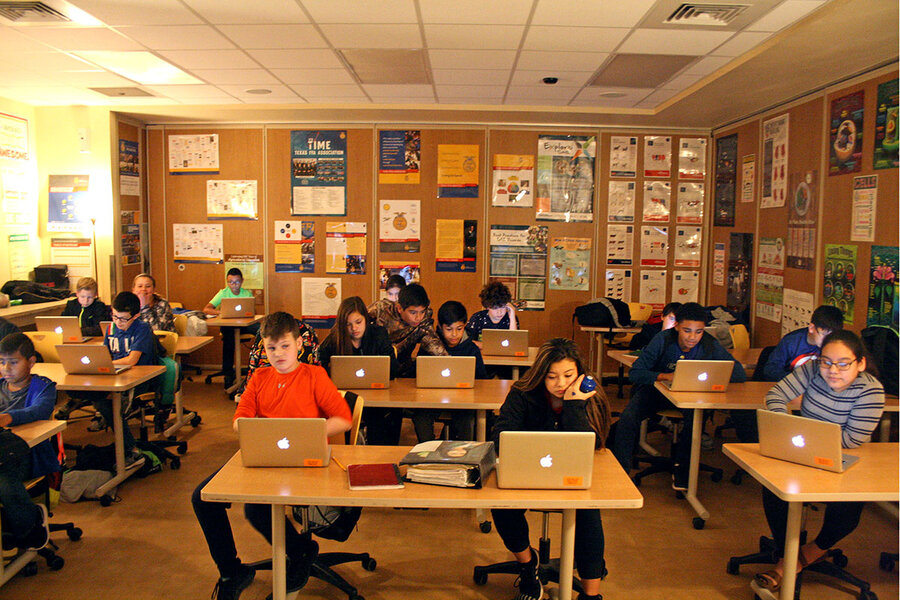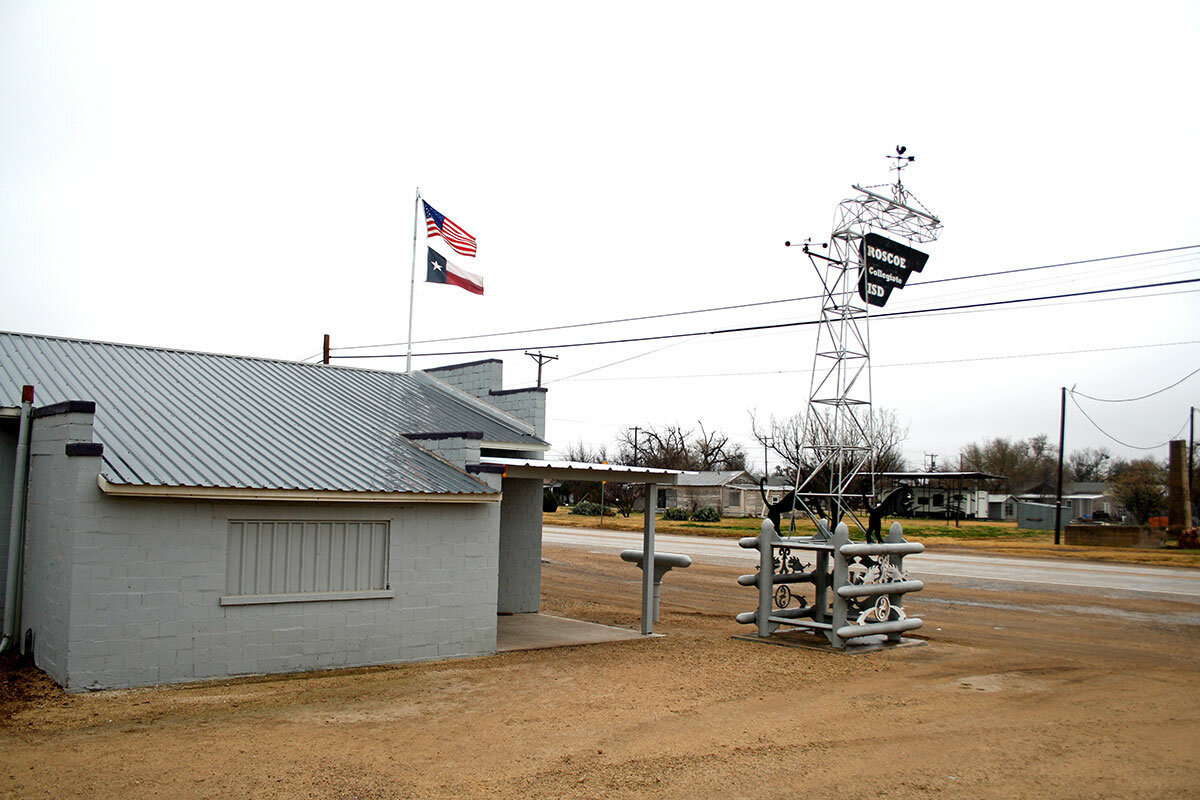This Texas town breeds something students need: confidence
Loading...
| ROSCOE, TEXAS
Ten years ago the school district in this small rural town faced a choice that would cut deep in the heart of every Texan: keep its 11-man football program, or downsize to a 6-man program?
Sitting where west Texas oil fields meet north Texas farmland, the high school student population here had dropped below 300, so funding had dropped as well. Six-man football, or consolidation with other school districts nearby, seemed a question of when not if.
Rural communities across the United States have been in decline for decades, with their schools struggling along with them. In Texas, rural school districts – which make up more than half of the state’s 1,240 districts – are grappling with several issues. Funding from the state has been decreasing for years. Fewer people are becoming teachers, and those who are want to work in urban areas. Students in rural schools are performing as well as their peers elsewhere, but often struggle after graduating.
Why We Wrote This
Faced with declining enrollment and funds, rural schools are in problem-solving mode. Roscoe, Texas, pushed for changes aimed at breaking the cycle of poverty. What lessons might its approach hold for other districts like it?
A decade ago, the Roscoe school board decided against downsizing, and it didn’t stop there.
In 2009 the school district implemented early college programs, in which students can graduate with both a high school diploma and a two-year associate’s degree. Three years later the district incorporated STEM – science, technology, engineering, and math – programs. Today Roscoe high school students are spread around town learning to weld and build robots, and are working as drone pilots and in a local pet hospital. Enrollment has doubled since the district decided to retain 11-man football a decade ago.
Roscoe’s approach is being sought out as a model within the state, even as experts suggest it may not work for every rural community and is not without drawbacks. Much of the district’s enrollment growth has come from transfers, with neighboring districts losing students – and funding – as a result. Limiting a brain drain by encouraging graduates to return to the town is also an emerging goal. But with a 95 percent graduation rate currently, the district has been attracting a lot of attention.
“What’s exciting about Roscoe is what they’ve done [around] making sure those students have opportunities after they graduate,” says Marian Schutte, director of system support and innovation at the Texas Education Agency (TEA). “Their district is something we look at in terms of gathering ideas to replicate statewide.”
A collaboration with industry
On a cold, gray morning in early December, the parking lot outside Roscoe Collegiate High School is full of mud-splattered pickup trucks and SUVs. Many of the students aren’t inside the school building, however.
They are instead scattered around the town (pop. 1,293) at various class programs the school district has set up with local industry partners. There they get practical education and experience for the STEM track of their choice: engineering or biomedical.
“The face of the new high school is very collaborative with industry – putting students in opportunities to build job skills, soft skills, employability skills,” says Andrew Wilson, the high school’s provost. “We’ve had to get creative in how to make that happen in rural settings.”
There’s the old Nitzsche family welding and blacksmith shop on Broadway Street where high schoolers in the engineering STEM track learn to weld. Students in the biomedical STEM track take classes – and, with the right certifications, can work – in the open-to-the-public “Edu-Vet” pet hospital five minutes west of town. Shelansky’s, an old dry goods store downtown, houses “Edu-Drone,” where students learn to build and fly drones.
Increased academic expectations make up the other half of Roscoe’s new approach. District goals include having 90 percent of seniors graduate with an associate’s degree, having 90 percent of those graduates get a bachelor’s degree, and having 90 percent of them get a more advanced postgraduate degree.
Early college offerings mean that Roscoe high schoolers can graduate with an associate’s degree from Western Texas College (WTC), essentially going into a four-year college as a junior.
That, combined with the technical training they get in the STEM programs, means students are leaving Roscoe “knowing there’s something they can do to contribute to the world,” says Nicholas Anthony.
Dr. Anthony moved to Roscoe in the mid-1990s when his father got a job managing the grain elevator there. He was one of the few to graduate and go on to get an advanced degree, and he now runs a chiropractic practice in nearby Abilene and has a clinic in Roscoe two days a week, where he often sees Roscoe student-athletes.
“They’re thinking, ‘I’m not just a kid from little old Roscoe,’ ” he says. “It’s enabled them to not ever see that there’s a ceiling on their capabilities.”
Launching, and returning?
Rural students graduate high school at higher rates than the national average, according to the National Center for Education Statistics, but only 61 percent of them go to college right after, compared to 72 percent of urban students and 74 percent of suburban ones, according to the National Student Clearinghouse.
And for those who do go to college, finishing their degree can be challenging as well, says Sylvia Leal, senior program officer at the T.L.L. Temple Foundation, a nonprofit focused on strengthening communities in rural east Texas.
“In urban schools we have students, first-generation students, that struggle to get access to higher education…. It’s the same in the rural setting but from a different perspective,” she adds. Rural students often struggle “for reasons that really are outside of their control. It’s too far, they can’t access [things], they don’t have the money to get there.”
This has not been the case so far for Kayla Justiss, a Roscoe graduate now in her first year at Texas A&M University in College Station.
She transferred to Roscoe after reading about the veterinary program. Four 16-hour semesters, two veterinary assistant certifications, and many late nights of school work later, she graduated with an associate’s degree.
“I got to A&M and thought, ‘This is a breeze, it’s easier than doing online classes at WTC,’ ” she says.
Her two years at Roscoe have also helped financially. She is classified as a junior at Texas A&M, and hopes to finish her bachelor’s degree in a couple years.
“I’m putting myself through college pretty much, so it’s a big help that I’m not having to pay for [first-year] classes,” she says. “I don’t have to get a waitressing job, I have more experience, and I can start working in my career field.”
Finding a way to also reap the benefits locally is the next challenge, says Kim Alexander, the Roscoe Collegiate Independent School District superintendent.
The key to that, he adds, is building a four-year college in Roscoe so people can get a bachelor’s degree without having to pay to relocate. He hopes they will have it up and running by fall 2019.
“We think if we get more who get a four-year degree here in Roscoe, more will stay in Roscoe,” he says. “If you educate them where they live you’ll have more folks stay in rural areas.”
Growing Pains
In the meantime, a more immediate issue with Roscoe's approach is that it is drawing students from other towns. Forty-three percent of the district’s students are transfers, according to Mr. Wilson. With state financing linked to enrollment in Texas, losing students can often mean losing funding, and for small rural districts with just a few hundred students even having a small number transfer can be significant.
Roscoe has “a very successful program,” says Jimmie Don Aycock, a former state representative who chaired the Public Education Committee and who has visited Roscoe several times. But, he notes, pulling students from other districts “makes life for those other small communities around them very difficult.”
Dr. Alexander, the superintendent, says that’s why state officials want to increase the number of rural districts following the Roscoe model as quickly as possible. The TEA is helping them do it, with the goal of having 60 districts adopt the model by 2023. Ultimately, Alexander says he wants Roscoe to be competing with other public school districts like his.
Dr. Leal, at the T.L.L. Temple Foundation, suggests that rural districts need to explore a range of solutions. She works with 159 districts in her region of east Texas, and 82 percent of those have fewer than 1,000 students. Other models they are looking at include collaborating on a hub site where students from multiple districts go for dual-credit offerings and apprenticeships – like Lee College, near Houston, for example – or pooling their resources so costs are shared among cash-strapped districts.
Roscoe’s “is a great approach, I’m very impressed with it, but it’s not a model yet,” she says. “Superintendents have to explore many different options.”
Still, Alexander notes the progress that has been made in Roscoe since 20 years ago, when he was the high school principal. “If [students] were economically disadvantaged, in most cases walking off the graduation stage was like walking off a cliff,” he says.
“If we’re able to engage this larger and growing nontraditional population of students in higher education … it solves a lot of problems,” he adds. “We want to break generational poverty through education.”








